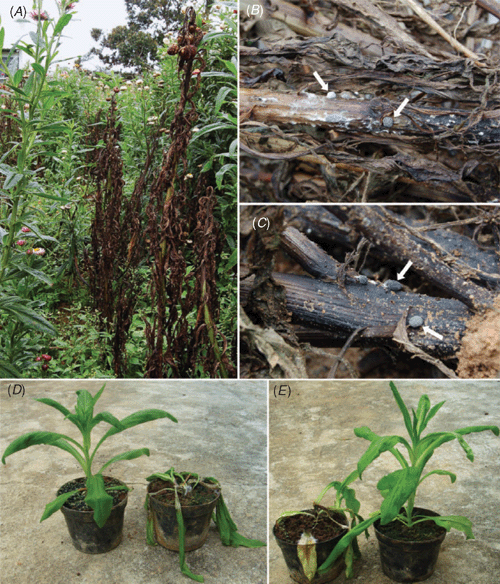First report of stem rot of Helichrysum bracteatum by Sclerotinia sclerotiorum in Brazil
L. L. Duarte A and R. W. Barreto A BA Departamento de Fitopatologia, Universidade Federal de Viçosa, 36570-000 Viçosa, M.G., Brazil.
B Corresponding author. Email: rbarreto@ufv.br
Australasian Plant Disease Notes 4(1) 100-101 https://doi.org/10.1071/DN09042
Submitted: 23 August 2009 Accepted: 2 September 2009 Published: 28 September 2009
Abstract
Sclerotinia sclerotiorum is recorded causing stem rot of Helichrysum bracteatum for the first time in Brazil.
Helichrysum bracteatum (Vent.) Andrews (common names: paper daisy, everlasting, strawflower) is an ornamental plant, native to Australia and popular worldwide (including Brazil) for the beauty and durability of their flowers which is mirrored in one of its popular names ‘eternal flower’ (Nishikawa et al. 2008). In September 2008, a disease was observed attacking a H. bracteatum flower bed in the campus of the Universidade Federal de Viçosa (Viçosa, State of Minas Gerais, Brazil) (Fig. 1A). Symptoms started as localised necrosis of the stems that quickly expanded leading to the girdling of stems and finally plant wilt and death. These were accompanied by the development of a white cottony mycelial growth over injured tissues. Later whitish aggregates of mycelia appeared that developed into dark rounded to elongated sclerotia, up to 1 cm long (Fig. 1B, C). The fungus was consistently isolated from surface-sterilised fragments of diseased stem tissues on potato carrot agar (PCA) at 25°C and was identified as Sclerotinia sclerotiorum (Lib.) de Bary based on its morphological characteristics (Mordue and Holliday 1976). A specimen was deposited in the local herbarium (Herbarium Vic.) under the accession number Vic. 31214.

|
In order to demonstrate the pathogenicity of the isolates of S. sclerotiorum obtained from H. bracteatum, 55-day-old healthy plants were inoculated both with mycelial plugs taken from 7-day-old cultures on PCA which were placed on leaf axils (Fig. 1E) or by the insertion of S. sclerotiorum-colonised toothpicks into the base of the stems of healthy plants (Fig. 1D). Sterile toothpicks were previously placed on the surface of colonies in PCA for 2 weeks at 25°C to allow them to be overgrown by S. sclerotiorum mycelium. The inoculated plants were kept in a moist chamber for 2 days and were then transferred to a greenhouse at ~25°C. Control plants were treated similarly, with the exception that the agar plugs and the toothpicks were sterile. After 2 days it was possible to note the initiation of stem necrosis and 7 days after inoculation the plants collapsed and died. Sclerotinia sclerotiorum was re-isolated from infected tissues. No symptoms were observed in control plants. This is the first report of Sclerotinia sclerotiorum as a pathogen of H. bracteatum in Brazil.
Sclerotinia sclerotiorum is a very poliphagous fungal pathogen and has a worldwide distribution, causing severe losses in many crops (Boland and Hall 1994; Bolton et al. 2006). Although it has been recorded on H. bracteatum in China (Tai 1979), Taiwan (Anonymous 1979), India (Boland and Hall 1994), Japan (Jun and Hiromichi 1999) and Argentina (Cundom and María 2000), it has not previously been recorded on this host in Brazil (EMBRAPA Recursos Genéticos 2009) and this is to be regarded as the first record of this fungus-host association in Brazil.
Boland GJ, Hall R
(1994) Index of plant hosts of Sclerotinia sclerotiorum. Canadian Journal of Plant Pathology 16, 93–108.
(Accessed August 2009).
Jun T, Hiromichi H
(1999) First Occurrence of Sclerotinia Rot in Aster and Strawflower in Japan. Proceedings of the Kanto-Tosan Plant Protection Society 46, 57–59.

Nishikawa K,
Ito H,
Awano T,
Hosokawa M, Yazawa S
(2008) Characteristic Thickened Cell Walls of the Bracts of the ‘Eternal Flower’ Helichrysum bracteatum. Annals of Botany 102, 31–37.
| Crossref | GoogleScholarGoogle Scholar | PubMed |



